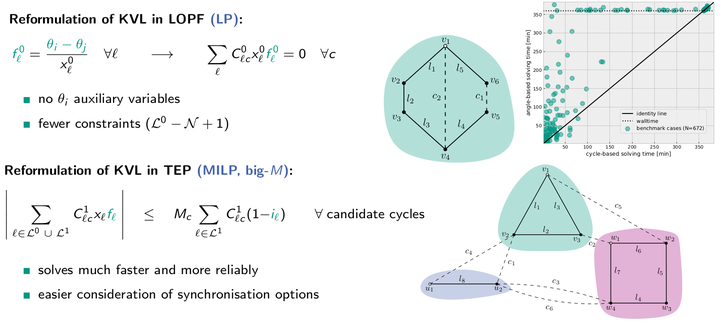Transmission Expansion Planning Using Cycle Flows

The common linear optimal power flow (LOPF) formulation that underlies most transmission expansion planning (TEP) formulations uses bus voltage angles as auxiliary optimization variables to describe Kirchhoff’s voltage law. As well as introducing a large number of auxiliary variables, the angle-based formulation has the disadvantage that it is not well-suited to considering the connection of multiple disconnected networks,
It is, however, possible to circumvent these auxiliary variables and reduce the required number of constraints by expressing Kirchhoff’s voltage law directly in terms of the power flows, based on a cycle decomposition of the network graph. In computationally challenging benchmarks such as generation capacity expansion with multi-period LOPF, this equivalent reformulation was shown in previous work to reduce solving times for LOPF problems by an order of magnitude. Allowing line capacity to be co-optimized in a discrete TEP problem makes it a non-convex mixed-integer problem.
This paper develops a novel cycle-based reformulation for the TEP problem with LOPF and compares it to the standard angle-based formulation. The combinatorics of the connection of multiple disconnected networks is formalized for both formulations, a topic which has not received attention in the literature. The cycle-based formulation is shown to conveniently accommodate synchronization options. Since both formulations use the big-M disjunctive relaxation, useful derivations for suitable big-M values are provided. The competing formulations are benchmarked on a realistic generation and transmission expansion model of the European transmission system at varying spatial and temporal resolutions. The cycle-based formulation solves up to 31 times faster for particular cases, while averaging at a speed-up of factor 4.